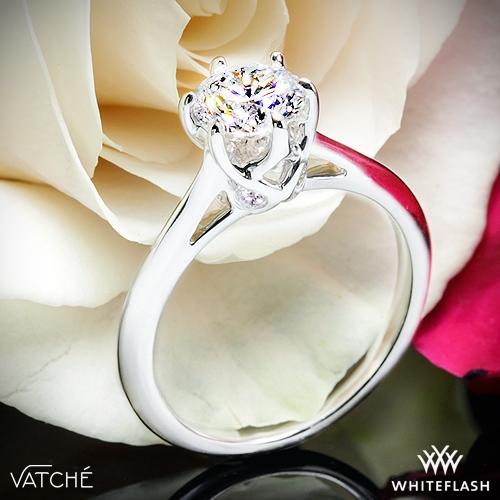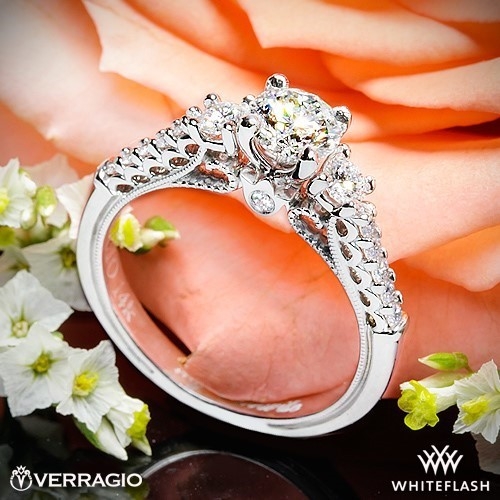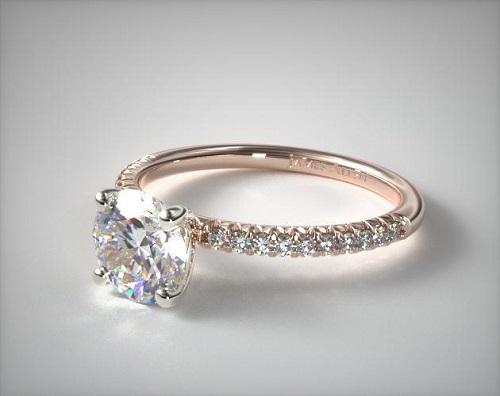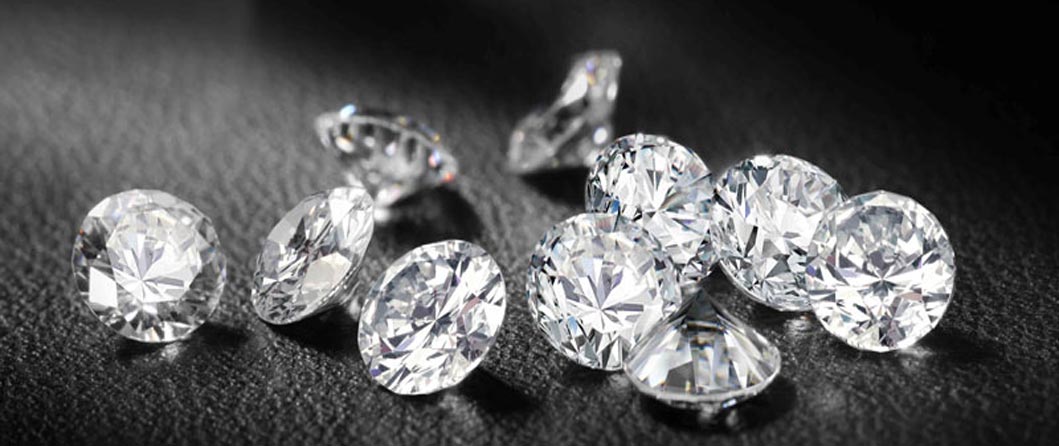
How to Tell if a Diamond is Real or Fake
October 11, 2017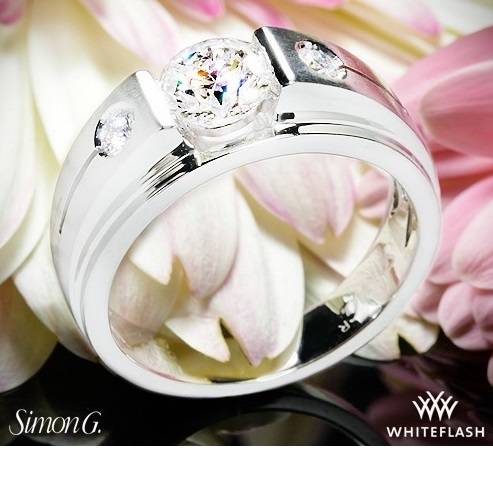
Diamonds on Men’s Wedding Rings
November 14, 2017Platinum vs. White Gold vs. Yellow Gold vs. Rose Gold
This page contains references to diamonds or engagement rings from different companies. Sometimes I do receive a commission when you click on links and buy the products.
Beauty is in the eye of the beholder. Everyone has their own preference for different metals used in settings. Your skin tone, your family’s traditions, current fashion, emotions, and simply what you like will all affect which metal you use in a ring setting. However, the four primary contenders for diamond rings are platinum, white gold, yellow gold and rose gold. What are the different qualities of each? And why does it matter?
Let’s take a look at this beautifully classic, yet elegantly modern, Vatche Swan Solitaire Engagement Ring from Whiteflash. It’s a perfect example for different settings. Whiteflash price their center diamonds individually so this enables you to compare the settings alone. For the ring made in white gold or yellow gold it will cost you the same. To have it in rose gold you’re looking at an additional $100, and for platinum you’re looking at over $300 on top of the original setting price. So why is this? Are some settings better than others?
The Four Types of Metal
So let’s take a closer look at these four different types of metal including the advantages and disadvantages of each. This should enable you to select the right metal for you and your budget.
Platinum
Platinum is our higher price-tag metal and as such it is often sought after. Compared to the three gold options, it is a nearly completely pure metal. It’ll be 95%+ pure. It’s hard-wearing and should stand the test of time. It’s strikingly different from yellow gold and rose gold because of its silver appearance.
It also has some huge advantages over gold. Platinum is hypoallergenic, whereas unfortunately we do come across people who struggle with adverse reactions to gold jewelry, especially white and rose gold. It is rarer than gold, making it a more exclusive choice, which of course leads to an aura of prestige. Its brightness makes it ideal for fair skin tones.
However, it has one major disadvantage: very few people will be able to tell the difference between platinum and white gold with the naked eye. Therefore, is it really worth it? No metal will stand the test of time without care, and platinum is no exception. You will need to have the ring cleaned and polished regularly.
Yellow Gold
Yellow gold will in fact be a mixture of metals. Gold itself is very soft and as such it is mixed with metals such as zinc or copper to make it more durable. 24 karat gold which is 99.9% pure is rarely seen in modern jewelry for this reason. Instead, we usually see 14 karat and 18 karat yellow gold which have 58.3% and 75% purity respectively. This is particularly important for engagement and wedding rings which are of course worn day-in-day-out for years.
Yellow gold remains a popular choice despite fashion swinging towards platinum in the last decade or so. It is historically the metal of choice. Whilst it is not as hypoallergenic as platinum, it is the most hypoallergenic of the three gold colors. Compared to the other colors it is also relatively easy to maintain. Additionally, due to the gold’s soft nature, it is relatively easy for jewelers to work with if you want to achieve a particularly intricate design. Typically, yellow gold looks particularly striking on individuals with a darker skin tone.
However, a traditional gold engagement ring does have a couple of drawbacks. You will need to care for it and have it polished and cleaned regularly. Dependent on the karat weighting you choose, it could be liable to scratch or dent.
White Gold
White gold tends to be in the running when an individual is considering a platinum ring. We’ll come on to a direct comparison between the two in a moment.
White gold is an alloy which is a mixture of metals. In the mix you’ll have pure gold, but you’ll also have other metals, for example, silver, nickel or palladium. These pieces are also usually coated with rhodium.
White gold should be considered alongside platinum simply because of its price tag. Owing to current fashion, white gold is still more popular than yellow gold despite its heritage. In addition, owing to the metals used for the alloy it is typically quite hard wearing. It’s a gold option for fairer skin tones.
However, there are a couple of drawbacks. As white gold is usually coated with rhodium, and this wears away over time, you’ll need to have the piece re-dipped from time to time. Nonetheless, this is straight forward and affordable. It’s also often mixed with nickel which is the metal behind many jewelry allergic reactions.
Rose Gold
There is no one color which is rose gold, it tends to be a spectrum and you’ll need to consider the individual ring. Once again, rose gold is an alloy. This time it is copper which is added to the pure gold to give it the distinctive pink hue.
Rose gold has been gaining popularity in fashion for both female and male wearers, and of course alludes to romanticism due to its pink color. It’s sometimes the cheapest of the settings because copper is relatively cheap. However, as our example at the beginning of the article shows, this is often not the case because there is less demand which pushes up the prices. Rose gold is also very tough thanks to its copper alloy and looks good on just about anyone.
However it has two main drawbacks. Firstly, it can be problematic for allergy sufferers. Secondly, despite being in fashion, it’s sometimes not given as a metal choice, and can carry a premium which isn’t really justified by its composition.
White Gold and Platinum
The comparison gets particularly confusing when we compare platinum with white gold. Both are intensely popular, and not many people can tell the difference at first glance. Yet platinum will cost you considerably more. Fundamentally the differences come down to four elements: cost, color, composition and care.
- Cost: We’ll start with cost as that one is easy to quantify. Platinum is always more expensive. This is interesting from the consumer’s point of view as you can’t normally tell much difference. However, platinum is immensely dense so you need more of it to make the same size setting. So it’s not the gram to gram comparison you’re looking at but purely how much denser platinum is. In my opinion, rather than spending the extra cash on an identical looking setting, you’d do better to invest in a more expensive center diamond.
- Color: This is usually the argument used in favor of platinum. However, can you really tell the difference between this Classic Tiffany Style Ring when you compare the two different images of white gold and platinum?
- Composition: A white gold ring is usually a mixture of metals. 18 Karat white gold is 75% gold with the remainder comprised of other metals such as nickel. This is because gold itself is a soft metal. Platinum on the other hand will have a much higher purity level, usually upwards of 95%.
- Care: The composition factor may lead you to think that therefore platinum is superior. However, in reality this higher purity means it tends to fare less well against scratches and bumps than gold which is composed of other metals in addition.
At the end of the day, choosing which metal you’d like for your setting really is an individual choice. All have pros and cons, and for you they will be differently emotively weighted. What is important is that you are getting excellent value for money. For us, it always makes sense to put any additional funds towards the diamond itself – on a purely logical and financial basis. However, you need to choose which option is best for you.


